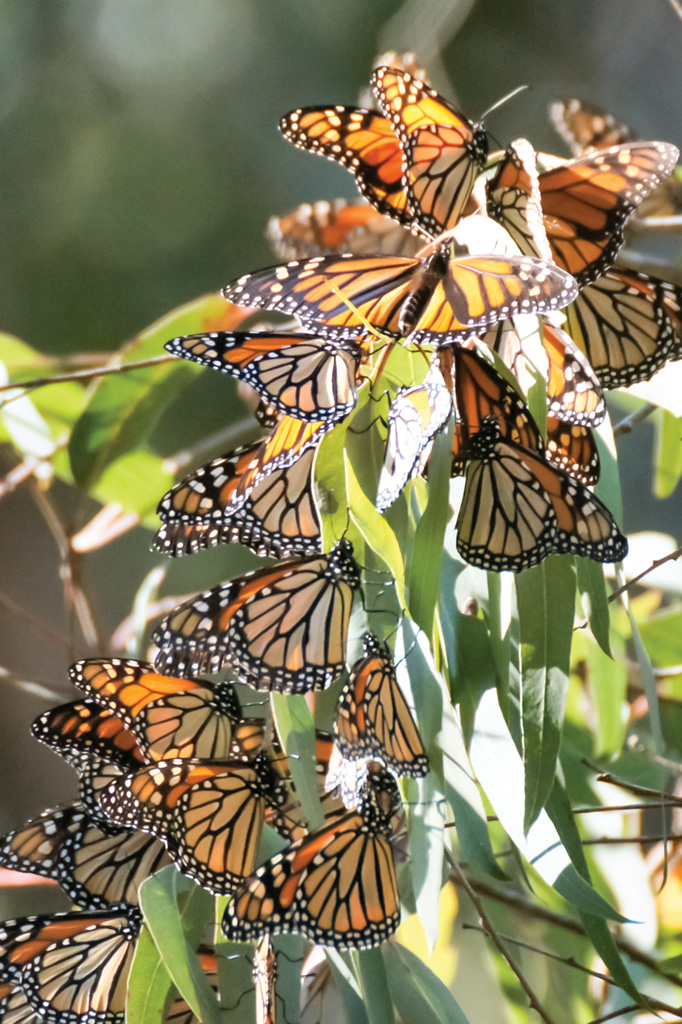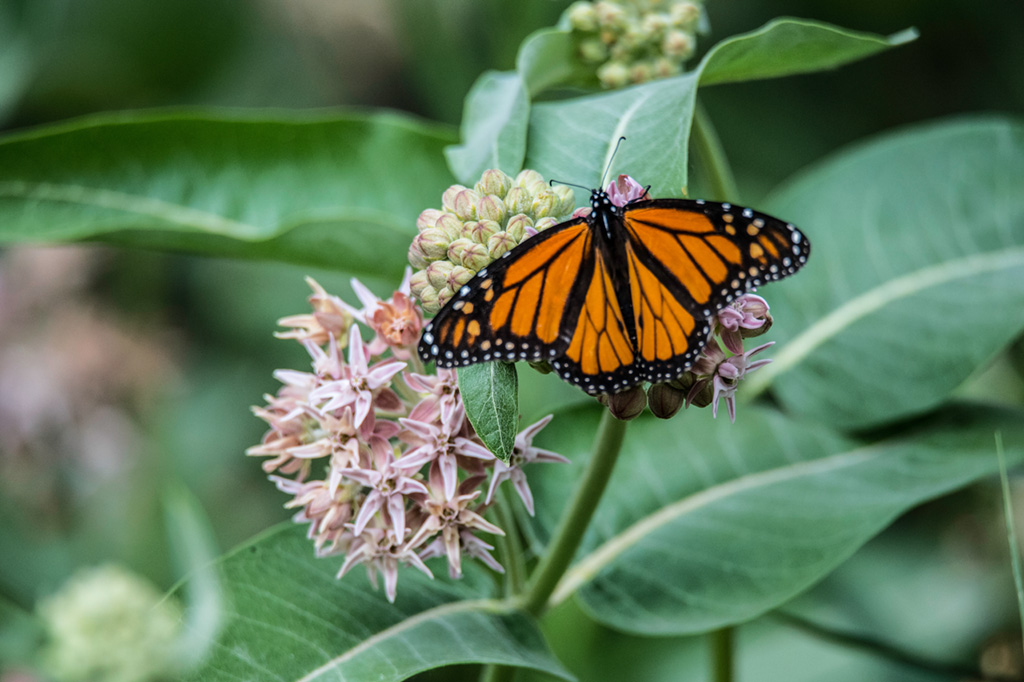If there’s any butterfly that people know, it’s the monarch. Its orange-and-black coloring helps it stand out against the landscape, and stories of its annual migration have charmed schoolchildren for decades.
Idaho, in particular, has a special connection with the monarch. In 1992, a group of fourth-graders—all dressed up as monarchs—persuaded the Idaho Legislature to name the monarch butterfly the state insect.
“It’s an iconic species in the West,” said Ross Winton, a regional wildlife biologist for the Idaho Department of Fish & Game in Jerome. “You can talk to just about anyone who’s spent time outdoors. They’re big and showy, and people tend to be attracted to big, showy creatures. Folks identify with it.”
But the monarch’s days in Idaho may be numbered, to the extent that it may be listed as an endangered species, or even become extinct.
Chemical Warfare
Generally, monarch butterflies survive better than other butterflies against predators because they’ve learned to use chemical warfare. Monarch butterfly caterpillars feed exclusively on one of the many species of milkweed, which gets its name because of the milky sap that comes out when you break it off. While monarchs have been known to feed on 27 varieties of milkweed, the different varieties have one thing in common: that milky sap contains several glucosidic substances called cardenolides, which are steroids that act on the heart muscle.
Studies have shown that those substances affect the monarch butterfly caterpillars, too. But in general, the monarch has evolved to metabolize this toxin and store it in its body, where it lasts through adulthood. “They’ve adapted to be able to consume the milkweed plant,” Winton said.
While the toxin doesn’t necessarily kill animals like birds and mice that eat butterflies, it tastes bad and makes them feel sick, to the extent that studies have shown that eating monarchs makes some birds throw up. “It wouldn’t give them a toxic overload, but birds do it once and don’t do it again,” Winton said.
While some other bugs and beetles have also learned to metabolize toxic substances, the monarch has coupled this ability with its bright orange-and-black coloring. “Predators identify the bright orange color as ‘don’t eat me,’” Winton said. In fact, it’s so effective that some other species, such as the viceroy butterfly, also have evolved to display a similar coloring. “The viceroy is a mimic,” he said. “It doesn’t taste bad, but its coloring persuades predators.”

Monarch caterpillars rely on the milkweed plant. Showy milkweed occurs naturally in 28 Idaho counties.
Winter Vacation
In the same way that East Coasters spend the winter in Florida and West Coasters spend it in Hawaii, Eastern monarch butterflies head down to Mexico for the winter, while Western monarch butterflies—including Idaho’s—head to central California locations, such as Pacific Grove, which hosts a monarch butterfly sanctuary. “Eastern and Western individuals do intermix occasionally,” Winton said.
Scientists know this, because they mark butterflies with tags the size of a hole punch. “Most of our tag returns have been picked up in central California,” Winton said. “We’ve never had a tag return from Mexico.”
How do the monarch butterflies know where to go? “I have no idea,” Winton admitted. It might be an internal compass, based on magnetic fields in the earth, or cues based on the length of the day, also known as the photoperiod. “As daylight gets shorter, that triggers their instincts to start heading south,” he said. Once on the road, the Eastern and Western butterflies have different flyways, guided by mountain ranges, the oceans, and wind currents.
The monarch butterfly lifecycle is complicated because different generations do different things. Adults come back from California in the spring, usually around June. Some of them have already mated; if they haven’t, they mate when they return to Idaho. Then they lay their eggs in Idaho on milkweed. The eggs hatch into caterpillars, which feed on the milkweed, then become a chrysalis, and then emerge as an adult butterfly.
“That adult will reproduce and lay a second generation of eggs,” Winton said. “When they emerge as adults, they’re the ones that migrate,” usually around September or October.
In fact, more than two generations may hatch in Idaho, said Emma Pelton, a conservation biologist with the Xerces Society, a Portland-based organization focusing on insect—especially butterfly—conservation. “Idaho breeding begins in June,” she said. “They’re breeding through August and early September, and then they leave.” But there aren’t distinct generations. “They’re probably producing two generations, but they’re overlapping,” she said. “We can’t quite tease out how many generations yet.”
Idaho Census
Monarch butterflies in Idaho haven’t been studied to the extent they have on the East Coast, though that is changing, Pelton said. Monarch butterfly population counts typically happen in the winter, in California, because they’re conveniently clustered, Pelton explained. In fact, there butterflies are counted weekly. “There’s nothing comparable anywhere else in Idaho,” she said. “This is a huge
data gap.”
Part of the problem is that, once the butterflies are on the move, tracking them is harder because they’re separated. Pelton’s organization has developed the Western Monarch Milkweed Mapper, which lets people report where they’ve seen milkweed and monarch butterflies.
And the counting process in Idaho is improving, Pelton said. “Over the past few years, Idaho has done an incredible job, the best of any state, to inventory monarchs and milkweed,” she said. Idaho Fish & Game hired four full-time technicians to cover the state in a standardized way, as well as performing climate change modeling to predict how habitat will be affected in the future,
she said.
Monarch butterflies have a variety of unusual fans who are helping. The Department of Defense, for example, monitors monarch butterflies near Mountain Home Air Force Base, to develop baseline data in case the monarch butterfly is placed on the endangered species list. “They want a proactive understanding of the distribution on their lands and avoid the impacts, so they can plan if it gets listed,” Pelton said.
The Idaho Transportation Department (ITD) is also helping. For example, the Bliss Rest Area Westbound has a project implemented in 2018 where it partnered with the U.S. Fish & Wildlife Service in Boise, the Bureau of Land Management, and Native Roots to design and construct a small demonstration project to promote public awareness and education on pollinators and native plants, said Cathy Ford, roadside program manager. Part of that project included planting showy milkweed, the type most common in
Idaho, to help support monarch butterflies, she said.
Other Idaho monarch counting and preservation projects are with the College of Western Idaho at the Deer Flat National Wildlife Refuge, Pelton said.

Although numbers are dwindling, Idaho’s monarchs come from California around June and lay their eggs
on milkweed.
Threats to Existence
The problem that Idaho and other western monarch butterflies are having is that there are threats to their existence all along that lifecycle, and a number of situations are combining that make it worse. Last year was particularly bad.
“The whole population crashed,” Winton said. “It’s been on a pretty steep decline for the last couple of decades, but there’s been an 86 percent population decline since last year.” And since recordkeeping started in the 1980s, the Western population has declined 99.5 percent, he added. “I put out 60 tags two years ago,” he said. “Last year, I saw two, and got no tags out.” Other people in southern Idaho reported the same thing, he said. “It’s been a low year from the get-go.”
“The population is at a historic low,” Pelton agreed.
What causes it? One issue is development in coastal California that is destroying monarch butterfly winter habitat. “Coastal California used to have lots of conifers,” Winton said. “Because of development, the naturally occurring trees disappear and have been replaced by eucalyptus.” While the butterflies have adapted to that, the eucalyptus trees are also starting to disappear, due to age and further development.
In addition, with climate change, there have been more wildfires, especially in California. That not only reduces the number of trees where monarchs live in the winter, but also the flowers they feed on during their migration.
It’s the lack of food sources along the migration path to California that are also an issue. “They have to recharge their batteries as they’re migrating,” Winton said. “There’s not as many naturally occurring plants blooming late in the season.” Climate change could also be a factor, because as the temperature increases, the growing season for those flowering plants shortens, he said. “They’re only out for a few days, as opposed to a few weeks.”
While there’s been a big push to plant milkweed to help support monarchs, that only helps during the caterpillar phase of the monarch butterfly’s life.
“Getting more caterpillars is fantastic, but the butterflies need resources to make their migration,” Winton said.
In fact, this year could be the turning point for whether the monarch butterfly survives in Idaho. It had already been estimated by scientists that the Western population might go extinct in 20 to 30 years, but last winter’s population crash bumped that up substantially, Winton said. But there’s still a chance.
“Winter was wet down south, but the flowers are doing really well in the deserts,” Pelton said. But it’ll be tight. “The numbers are getting so low that there’s a concern about whether they will be able to replace themselves, due to predation,” he said. “The projections are that, unless we have a banner year, they won’t be able to replace themselves in the population.”
That doesn’t mean monarchs will go extinct altogether, but the Idaho population and its California migration could end, Winton said. “In recent years, monarch butterflies in Southern California have established themselves year-round, and don’t migrate at all,” due to a variety of tropical milkweed that doesn’t die off and provides the butterflies with a constant food source, he said.
A Monarch’s Value
So what would be the problem if monarchs left Idaho? They don’t fulfill a major role in the ecosystem; it’s not like honeybees, where farmers depend on them to pollinate the crops.
But monarchs are the canary in the coal mine, as it were. “They’re a flagship species,” Winton said. “They don’t necessarily play an ‘uber’ important role in the ecosystem. But they represent the larger role of insects getting out of whack.”
And there’s more to it than that. “It’s a cultural thing,” Winton said. Generations of kids will no longer be able to watch monarchs, collect a chrysalis, and watch the butterfly emerge. “That’s going to be lost,” he said.

